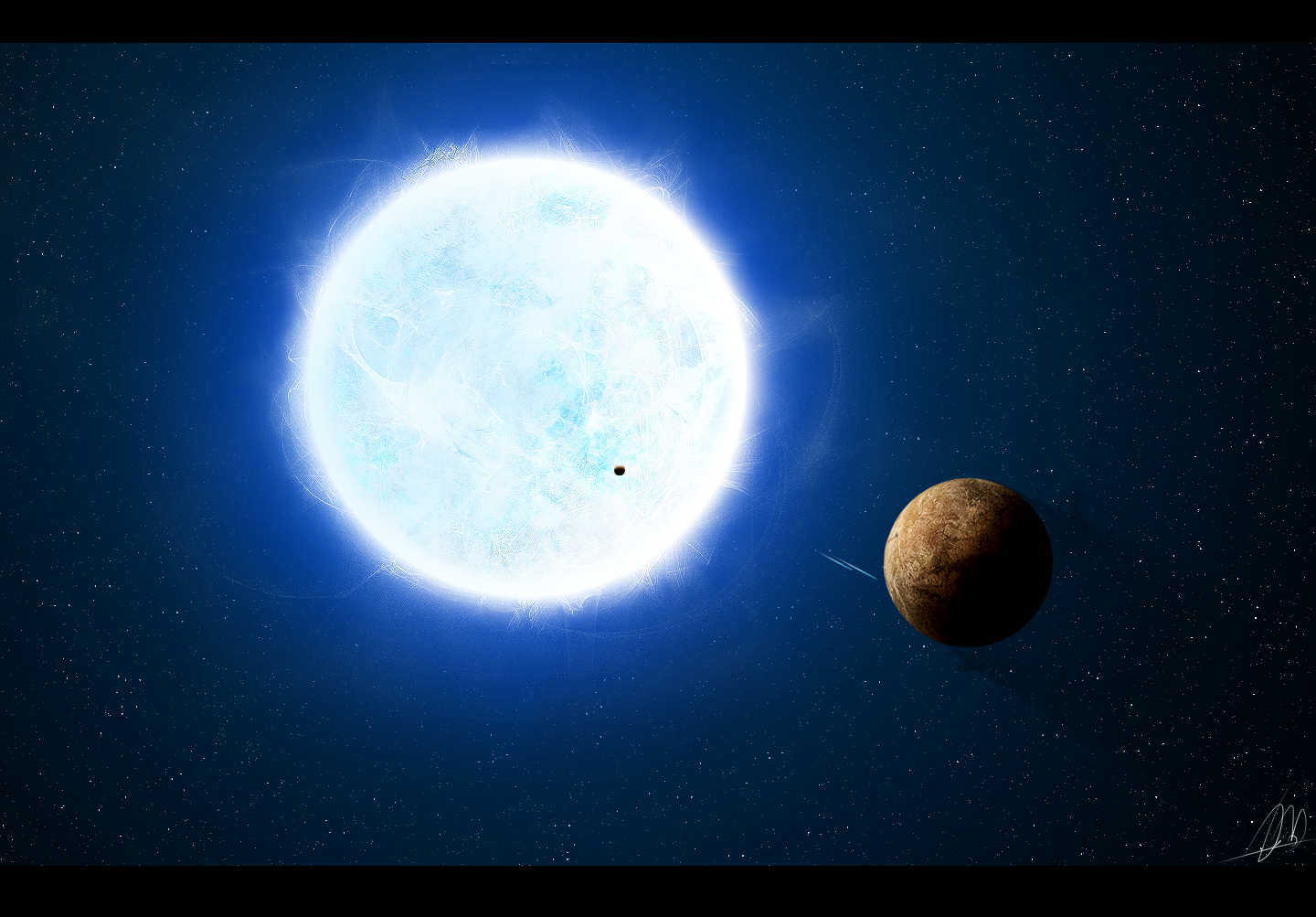Artist's rendition of planets orbiting their white dwarf, the product of a once magnificent star
High-mass stars have a far more exciting death. As mentioned in the previous post, these stars are massive enough to keep fusing up to iron. When iron is reached, heat is absorbed and the star collapses from its own gravity. The star implodes, fusing elements heavier than iron like uranium very quickly. Then, by a process still not completely understood, the star rebounds and creates a massive explosion in space. This explosion, called a supernova, is bright. Its luminosity is greater than the combined luminosity of all the stars in its own galaxy. In 1054 AD, a star's light that had gone supernova reached Earth and illuminated the night sky. It was bright enough to be seen in the daytime as well. These extraordinary events release gamma ray bursters, an event that would have catastrophic consequences for a planetary system near enough. Scientists believe Earth was hit by a gamma ray burster that rendered 99% of Earth's inhabitants extinct some time in prehistory, long before the dinosaurs.
The image shown above is the Crab Nebula, it is the aftermath of the supernova witnessed in 1054 AD
After the supernova, stellar cores of less than three solar masses become neutron stars. Basically a star composed of neutrons, they are incredibly dense. Their density is equivalent to sticking the mass of the Sun into the area of Manhattan. A teaspoon of neutron star material would weigh more than a battleship. Due to the law of conservation of angular momentum, the core rotates phenomenally fast, often time spewing material out of its magnetic poles. This is known as a pulsar and is akin to a cosmic lighthouse.
Pulsars are highly magnetized, so they have strong magnetic fields. The image shown is not what a real pulsar would look like
The final fate for a stellar core of more than three solar masses is a black hole. Incredibly perplexing objects, it was only until the 70's before they were discovered in space. Black holes are a region of space-time that is so dense that light itself cannot escape the gravity. Everything has what is called an escape velocity. An escape velocity is the speed required to escape gravitational attraction. The Earth's is seven miles per second, meaning rockets that leave orbit must at least travel that speed. But a black hole's escape velocity is greater than the speed of light. If you will remember the posts about Einstein, it is impossible to travel faster than light, thus nothing escapes a black hole once it has passed through the event horizon. The event horizon is the point where the object chiefly becomes black. It is at this point that gravity is too powerful for light and photons are stuck in orbit around the black hole. At the center of a black hole is a singularity. A point where the laws of physics deconstruct and Einstein's theory of relativity fails. We do not yet know what occurs at the singularity, but it is one of the most sought out answers in physics. Black holes also grow as they "feed" on other objects. Their mass adds to the black hole's mass. The gravitational distortion of a black hole is so tremendous, that there is a point that to someone observing an object falling into the black hole, the object seems to stop. In fact, time itself seems to halt. But to the thing falling, time passes normally and it starts to stretch. Known as spaghettification, the objects is pulled apart, molecule by molecule, atom by atom, particle by particle and then is taken into the black hole's mass.

Artist's rendition of what a black hole looks like. Notice the distortion of the light around the object itself. This is called gravitational lensing and occurs when objects of high gravity distort light passing near them
Stars form, stars live, stars die. One day, the last star will blink out of existence, but tonight when you look up and see just one, enjoy it. We are living during a period of the universe where stars are able to form and it will not last forever. Cherish the stars, for they died so their atoms created in their core could coalesce into you and I. We take stars for granted, but they fade into darkness one day. But enjoy them until then.
Hi all, I am going to be starting on quantum mechanics next post so we can build into subjects too complex to be explored with only relativity and classical mechanics. Ask questions about the post, criticize, praise, be indifferent to stars, whatever. Hopefully you come back and read. Subscribe to the posts and keep checking back for some quantum physics! Until then, salutations!



I really like this post but why does the black hole distorts light when it is coming too close? Is it affected by how big the black hole is?
ReplyDeleteOh, and can you write another post?
ReplyDeleteBlack holes distort light because of their gravity field in which the beams of light are pulled in closer. The more massive a black hole, the more dramatic this lensing effect. I will be posting soon on atoms, sorry for the delay, busy week!
Delete